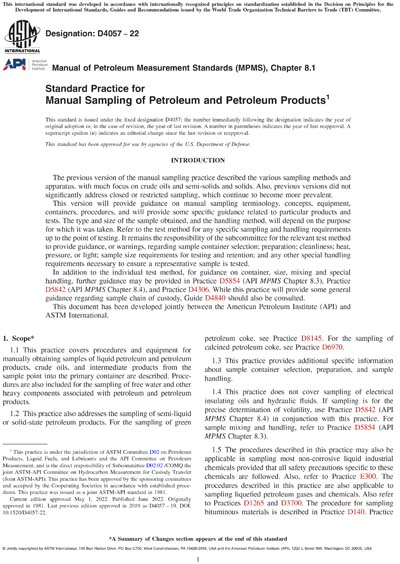Most recent
ASTM D4057-22
Standard Practice for Manual Sampling of Petroleum and Petroleum Products
1.1This practice covers procedures and equipment for manually obtaining samples of liquid petroleum and petroleum products, crude oils, and intermediate products from the sample point into the primary container are described. Procedures are also included for the sampling of free water and other heavy components associated with petroleum and petroleum products.
1.2This practice also addresses the sampling of semi-liquid or solid-state petroleum products. For the sampling of green petroleum coke, see Practice D8145. For the sampling of calcined petroleum coke, see Practice D6970.
1.3This practice provides additional specific information about sample container selection, preparation, and sample handling.
1.4This practice does not cover sampling of electrical insulating oils and hydraulic fluids. If sampling is for the precise determination of volatility, use Practice D5842 (API MPMS Chapter 8.4) in conjunction with this practice. For sample mixing and handling, refer to Practice D5854 (API MPMS Chapter 8.3).
1.5The procedures described in this practice may also be applicable in sampling most non-corrosive liquid industrial chemicals provided that all safety precautions specific to these chemicals are followed. Also, refer to Practice E300. The procedures described in this practice are also applicable to sampling liquefied petroleum gases and chemicals. Also refer to Practices D1265 and D3700. The procedure for sampling bituminous materials is described in Practice D140. Practice D4306 provides guidance on sample containers and preparation for sampling aviation fuel.
1.6Units - The values stated in SI units are to be regarded as the standard. USC units are reflected in parentheses.
1.7This standard does not purport to address all of the safety concerns, if any, associated with its use. It is the responsibility of the user of this standard to establish appropriate safety, health, and environmental practices and determine the applicability of regulatory limitations prior to use.
1.8This international standard was developed in accordance with internationally recognized principles on standardization established in the Decision on Principles for the Development of International Standards, Guides and Recommendations issued by the World Trade Organization Technical Barriers to Trade (TBT) Committee.
Content Provider
ASTM International [astm]






